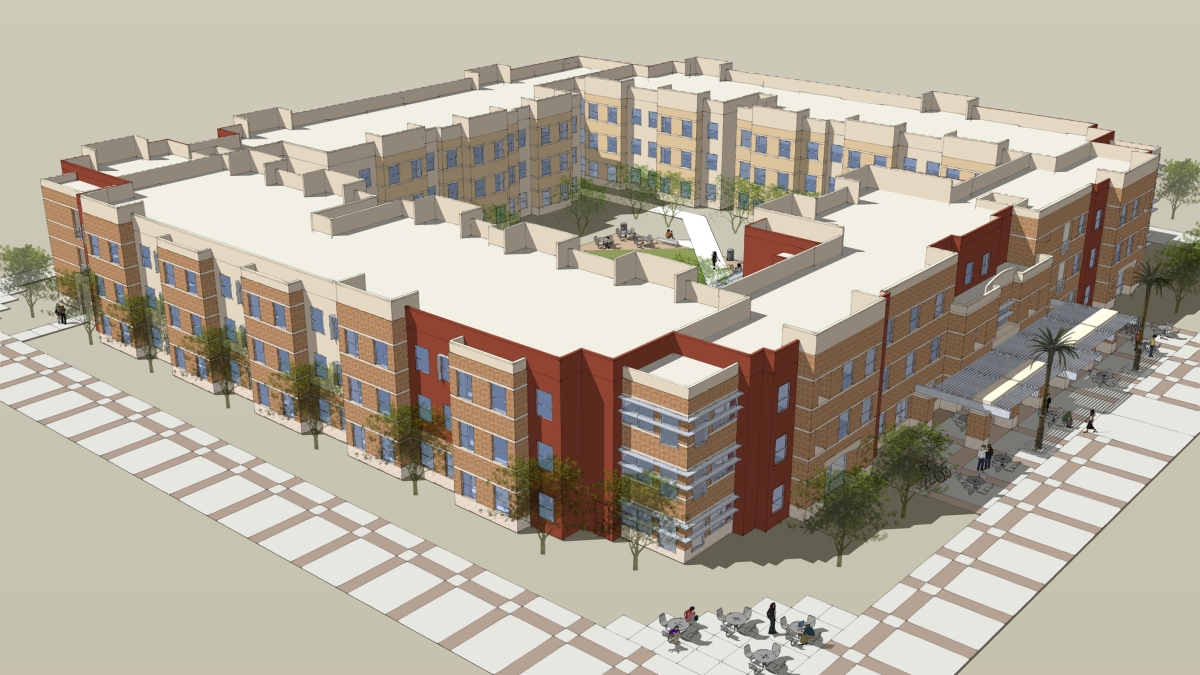ASU breaks ground for new West campus facilities

The growth taking place at Arizona State University’s West campus will soon be supported by the addition of a new residence hall and dining facility. The university celebrated the start of construction on these projects with a groundbreaking ceremony on June 15, with the public invited to attend.
The facilities are set to open for the beginning of the Fall 2012 semester on the campus at Thunderbird Road and 47th Ave., in northwest Phoenix.
The new residence hall, meant to serve freshmen and sophomores, will double the current number of on-campus beds for resident students. The existing Las Casas facility, with its apartment-style units, will be an attractive alternative for upperclassmen and graduate students.
The 365-bed, 93,000 square-foot residence hall will feature 109 one- and two-bedroom suite-style units for two or four residents. Amenities include a social lounge, gaming lounge, study rooms, a community kitchen for programming use, laundry facilities, a business center and an interior landscaped courtyard. The building is designed to meet LEED (Leadership in Energy and Environmental Design) Silver specifications.
The $14.3-million residence hall will be built and owned by American Campus Communities, with whom ASU worked to establish the successful Barrett Honors College and Vista Del Sol projects on the Tempe campus.
Among the amenities in the 37,000 square-foot dining facility will be open and private dining areas, late-night dining options, market-style servery areas and retail space. The Jamba Juice restaurant and Devils’ Den student lounge currently located in the University Center Building are expected to become part of the new dining facility.
The total project cost for the dining facility, also to be built by American Campus Communities, is $9.5 million. ARAMARK, the dining service provider, will contribute to the project.
No state dollars or tuition revenues are being used to fund the residence hall or dining facility.
“The West campus is a key asset for Arizona State University and for the West and North Valley,” said ASU President Michael M. Crow. “We are committed to making the campus a sought-after destination for outstanding students not only from the Valley but from around Arizona and the United States, and these new facilities will help us make continued progress toward that goal.”
The campus already has begun attracting increased numbers of out-of-state students, providing a boost to the local economy. In Fall 2010 nearly 25 percent of the newly admitted students to ASU’s New College of Interdisciplinary Arts and Sciences, the core college on the West campus, came from outside Arizona. Some of those students were drawn by the ability to take advantage of the Western Undergraduate Exchange program that enables students from 14 Western states to enroll in select majors and pay lower tuition than the regular non-resident rate.
“Research has repeatedly shown that university freshmen who live on campus have higher retention and graduation rates than those who do not,” said Elizabeth Langland, dean of New College and ASU vice provost. “We have added elements to the new residence hall and dining facility that are specifically designed to bring students together for academic and social interaction, which will enhance our sense of community on campus.”
Along with New College, ASU’s Mary Lou Fulton Teachers College and W. P. Carey School of Business offer degree programs on the West campus. Barrett, The Honors College also maintains an active presence on the campus, with students in all majors eligible to participate in Barrett programming.
The new buildings will add to the many facilities and services for students already offered at the West campus, including a full-service library, computing commons, tutoring services, disability resource center, dining options including Starbucks, dozens of student clubs, and opportunities for students to work with professors on research projects. A shuttle service is available for students who take classes on multiple ASU campuses.
ASU’s West campus is at 4701 W. Thunderbird Road in Phoenix. The groundbreaking event will be held on the multipurpose field west of the Sands Classroom Building. Visitors to campus may park in Lot 13, off University Way North on the north side of campus.

